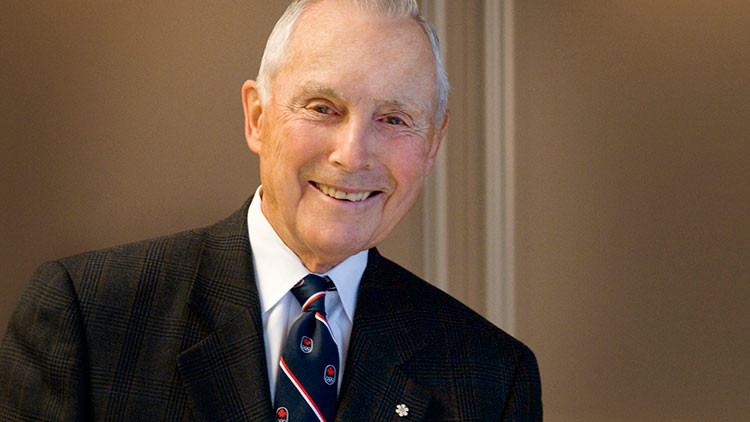Government mail service may be affected by the Canada Post labour disruption. Learn about how critical government mail will be handled.

"Engineers build for the future, not merely for the needs of people but for their dreams as well. Thus, inherently, the engineer’s work is a fearless optimism that life will go forward and that the future is worth working for"
A 1951 quote by one of Doc's heroes, General Dwight Eisenhower, that applies to Doc's forward-looking attitude and his commitment to building Alberta.
Doc Seaman’s life has been shaped by many forces, from the hard work of growing up in the Great Depression, to the sacrifice of wartime service, to the responsibility of building more than one successful company from the ground up. He has always met those challenges with trademark perseverance and a steadfast belief in the promise of a better future for Albertans and all Canadians.
Daryl Kenneth Seaman was born in Rouleau, Saskatchewan on April 28, 1922. His parents, Byron and Mae Seaman, were Americans who came north in search of new opportunities. Their family grew to include a daughter, Dorothy, followed by Daryl and his younger brothers, Byron and Donald. Farming sustained the family until Byron Sr. had built up the capital to launch a road building business. Doc remembers the Depression-era business as a tough “dawn to dark outfit.” In the mid-1930’s Doc joined the crew and soon learned a business fundamental that would serve him well - that it takes work hard and long hours to create success.
In between stints on the road crew, Doc indulged his love of sports. He was a gifted athlete who played junior baseball and honed his hockey skills against the province’s elite players. He also honed his emerging leadership skills and was often the one to be found organizing teams.
In 1939, Doc enrolled in technical school only to have his studies cut short by illness. The next fall, he was back studying Engineering at the University of Saskatchewan but his studies were again interrupted, this time by the Second World War. Although Doc was inclined to follow his friends into the South Saskatchewan Regiment, a recruiter steered him toward the Royal Canadian Air Force. Officer Seaman proved to be a natural pilot and leader who often commanded men many years his senior.
Doc’s crew flew increasingly dangerous missions over North Africa, Sicily and Italy. In 1943, their plane was hit by a German fighter, killing a crew member and badly injuring Doc’s leg. As the only pilot on board he had no choice but to fly the damaged craft to safety so the crew tied Doc’s shattered leg to the rudder and he guided them back to base. The mission earned the crew a Government of France Citation. After a period of recovery, Doc returned to active service on his 21st birthday.
By 1945, Doc had been discharged and was back at university. It was during this period that Daryl officially became “Doc.” He spent his summers studying and playing baseball with a Saskatoon team named the Army, Navy and Air Force Vets, carrying his gear to games in an old black satchel that looked like a medical bag. The nickname “Doc” was adopted by his teammates and quickly stuck.
By 1949, Doc and his brothers had all graduated as Mechanical Engineers and were ready to start their careers. They moved to Calgary and founded Bow Valley Industries, which grew into a highly-regarded sector leader. In business, Doc employed the same approach that had served him well during the war, believing that the success of any endeavour begins and ends with good people who have been given the direction and encouragement they need to get the job done right.
The brothers sold Bow Valley in 1992, which at the time was Canada’s largest financial transaction, and Doc went on to build other successful companies. He also focused on what had become an equal commitment to serving others. Doc has sponsored significant endeavours at the University of Calgary, including the development of highly innovative MRI and robotic surgery technology. Doc has also made key contributions toward a Urology Centre and three significant funds in his name under the Calgary Foundation have supported many worthwhile projects. Over the years, Doc has shared his energy with a wide range of organizations including the Calgary Homeless Foundation, the Canadian Red Cross, Engineers Without Borders, the Glenbow Museum, Literacy Alberta, Museum of the Regiments, Prairieaction Foundation and the United Way.
Sports have also been a focus of Doc’s community investments. He was a driving force in efforts to bring professional hockey to the city with the purchase of the Calgary Flames and was the founding Governor of the Hockey Canada Foundation. He served as Governor of the Olympic Trust of Canada and co-chair of a drive that generated significant support for the 1988 Winter Games. More recent sports investments have focused on building innovative multipurpose outdoor sports facilities for Alberta communities.
In 1987, Doc bought the OH Ranch, a heritage property west of Calgary. In doing so, he preserved a beautiful and important piece of Alberta’s western heritage while gaining the sense of peace that he derives from riding a favorite horse through the picturesque foothills of the Alberta Rockies.
Doc Seaman is an Officer of the Order of Canada and holds Honourary Doctor of Laws degrees from the Universities of Calgary and Saskatchewan. His is an Honourary Regent of Athol Murray College of Notre Dame and a member of the Canadian Oilmen’s Hall of Fame, the Saskatchewan Oilmen’s Hall of Fame and the Alberta Sports Hall of Fame (as a hockey builder). He is a recipient of the McGill University Management Achievement Award, the Paul Harris Fellowship from Rotary International and the Frank Spragins Award from the Association of Professional Engineers, Geologists and Geophysicists. The University of Saskatchewan has included Doc in its list of 100 Alumni of Influence from the past 100 years.
When asked to choose one thing that he hopes will serve as his legacy, Doc quickly points to the jobs he’s helped create. Remembering the hard times of the 1930’s, Doc maintains that his greatest satisfaction is the reward that comes from “taking a business, investing in it, making it successful…and seeing people earn a living from it.”
In reality, Doc Seaman’s influence extends well beyond the many jobs he has helped to create. It can also be seen in the lifetime of dedicated service he has offered his country and his considerable investments in the quality of life enjoyed by his fellow Albertans and all Canadians.
